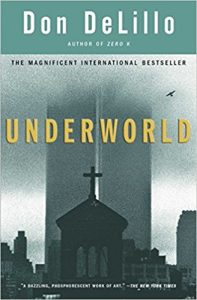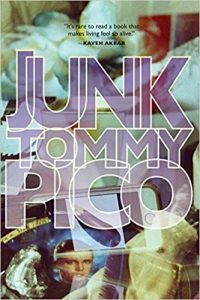by Colorado Review Associate Editor Christa Shively
 I remember a class I took as an undergraduate that focused on the works of postmodernist writer Don DeLillo. I recall the strong themes of trash and decay that ran through his novel Underworld. I was struck by how profound garbage seemed to be within the context of the novel, how it seemed to define not just a culture, but people as a whole. This was one of the first instances of daily detritus that I saw reflected in literature. It is often said that art reflects life, so it makes sense that if the world around us is emptying garbage into our oceans, allowing toxins into our soil and chemicals into our air at an alarming rate, then literature, by necessity, should explore that. In one part of the novel DeLillo describes a bomb test site: “And how strange it is, strange again, more strangeness, to feel a kind of homesickness for the things on the shelves in the houses that still stand, Old Dutch Cleanser and Rinso White, all those half-lost icons of the old life . . . .” In this way culture seems to be defined by what has been discarded. Since reading Underworld nearly a decade ago, I have noticed the inclusion of refuse in contemporary literature more and more.
I remember a class I took as an undergraduate that focused on the works of postmodernist writer Don DeLillo. I recall the strong themes of trash and decay that ran through his novel Underworld. I was struck by how profound garbage seemed to be within the context of the novel, how it seemed to define not just a culture, but people as a whole. This was one of the first instances of daily detritus that I saw reflected in literature. It is often said that art reflects life, so it makes sense that if the world around us is emptying garbage into our oceans, allowing toxins into our soil and chemicals into our air at an alarming rate, then literature, by necessity, should explore that. In one part of the novel DeLillo describes a bomb test site: “And how strange it is, strange again, more strangeness, to feel a kind of homesickness for the things on the shelves in the houses that still stand, Old Dutch Cleanser and Rinso White, all those half-lost icons of the old life . . . .” In this way culture seems to be defined by what has been discarded. Since reading Underworld nearly a decade ago, I have noticed the inclusion of refuse in contemporary literature more and more.
In the novel A Tale for the Time Being by Ruth Ozeki, the main characters are amazed to  find a teenager’s journal that has traveled across the Pacific Ocean. The disbelief comes not from the great distance that the journal has had to travel, but rather that the journal somehow missed getting sucked into one of the great floating garbage heaps. These garbage patches are enormous landmasses of synthetic and toxic waste, collecting more debris and getting bigger as they float: “The Great Eastern Patch is the size of Texas. The Great Western is even larger, half the size of the continental USA.” If we now have piles of waste the size of small continents, then it makes sense that our daily refuse would have such a large presence in the world of art and literature.
find a teenager’s journal that has traveled across the Pacific Ocean. The disbelief comes not from the great distance that the journal has had to travel, but rather that the journal somehow missed getting sucked into one of the great floating garbage heaps. These garbage patches are enormous landmasses of synthetic and toxic waste, collecting more debris and getting bigger as they float: “The Great Eastern Patch is the size of Texas. The Great Western is even larger, half the size of the continental USA.” If we now have piles of waste the size of small continents, then it makes sense that our daily refuse would have such a large presence in the world of art and literature.
Prose is not the only way that trash is making its way to the reader. In A. R. Ammons’s Garbage: A Poem, he uses trash to explore a life lived in beauty, disappointment, and utter wonder. This book-length poem feels like a conflation between what is disposable and what is transcendent. Tommy Pico, more recently, explores perhaps where A. R. Ammons left off, in his new book of poetry entitled Junk:
in stadium lights like so fantastically broken but I’m
gummy-
peachy keen Junk gets a bad rap because capitalism Junk
isn’t
garbage It’s not outlived its purpose—Junk awaits its
next life
I could go on about the influence of trash in contemporary culture; I feel as though sifting for the gems beneath the grime is half of what makes for such an interesting endeavor. With the breakdown of the systems in place to negotiate waste management and overflow (or rather hide them from the general public), it seems only natural that literature would be flooded with the sewage of our society in the same way.